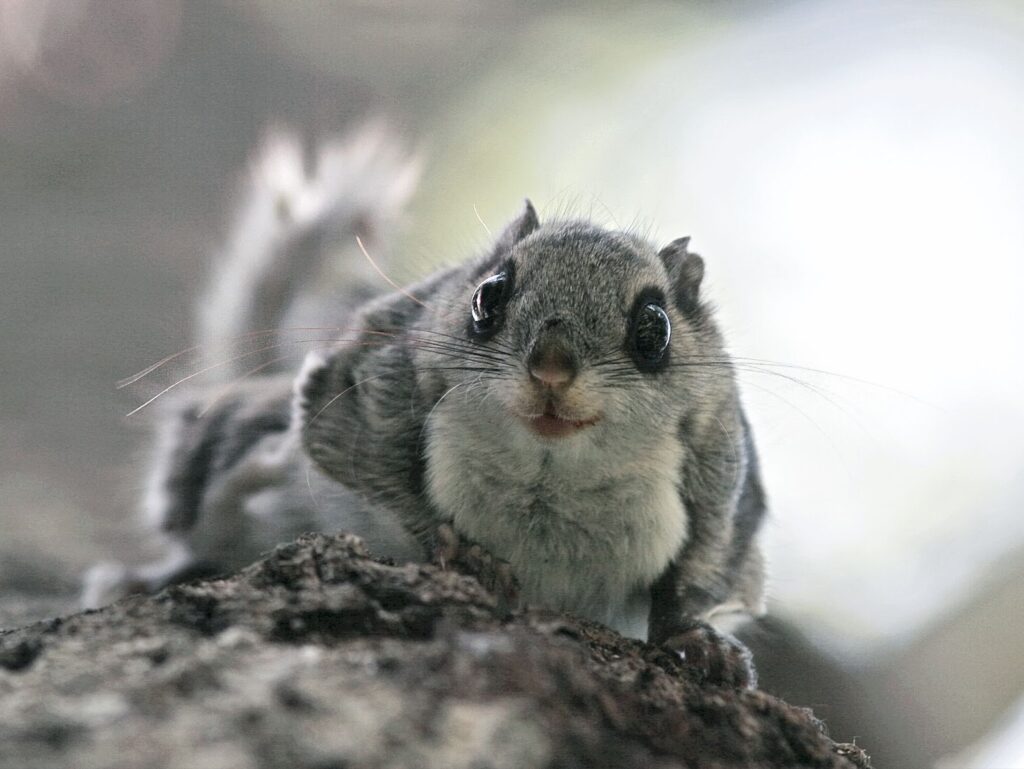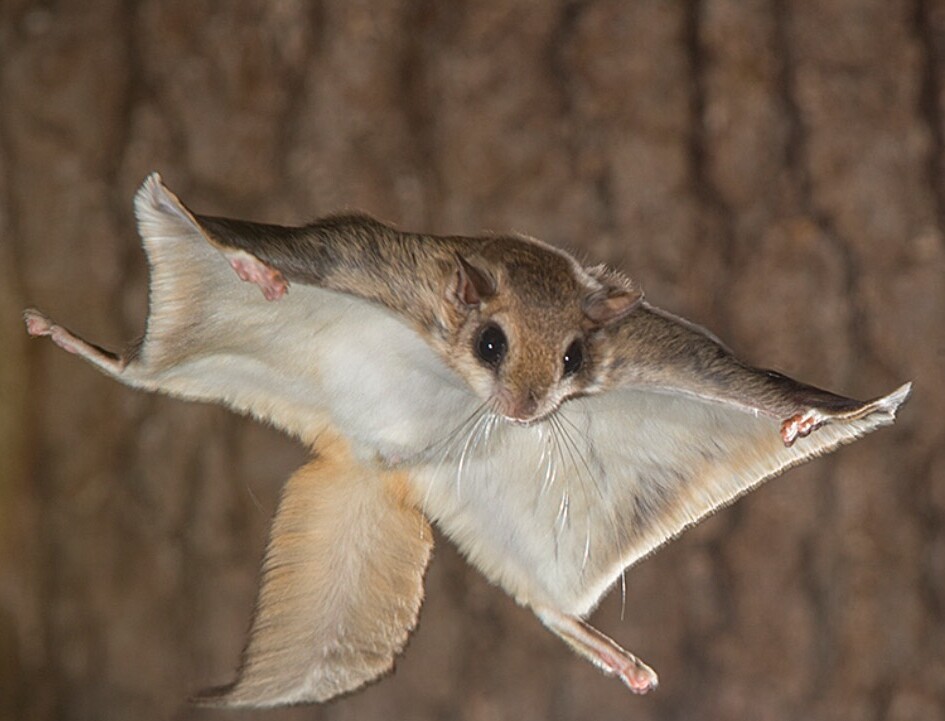Table of Contents
ToggleIntroduction

Flying squirrels (tribe Pteromyini or Petauristini) are a fascinating group of squirrels that have evolved a unique adaptation: the ability to glide through the air. These agile creatures have captured the curiosity and wonder of people worldwide due to their seemingly gravity-defying feats.
Unique Characteristics
What sets these squirrels apart from others is their unique ability to glide. The patagium, an elastic membrane extending from the wrist to the ankle, allows these animals to glide from tree to tree in search of food effortlessly or to escape predators.
When they leap into the air, they spread their limbs wide, the patagium fills with air, and they can control their trajectory by adjusting the tension in this membrane, steering with their limbs, and using their tail as a rudder. Seeing these small mammals sail smoothly through the air, making abrupt turns with perfect precision, is a breathtaking sight.
Another distinctive feature of the flying squirrels is their large eyes, an adaptation for their nocturnal lifestyle. The size of their eyes allows more light to enter, enhancing their night vision. They have sharp claws for gripping tree bark and a flattened tail that aids in stability during gliding.
Scope Of Species And Geographic Distribution
Flying squirrels are not a single species but a tribe encompassing around 50 species grouped into several genera. They are found all across the globe, from the forests of North America and Europe to the jungles of Southeast Asia.
The Japanese Dwarf Flying Squirrel lives in Japan, while the Northern Flying Squirrel (Glaucomys sabrinus) and Southern Flying Squirrel (Glaucomys volans) are widespread over North America.
Each species of flying squirrel has adapted to its specific habitat and has slightly different behaviors and diets. Despite the differences, they all share unique adaptations that allow them to glide, making them a fascinating subject of study in biology and aerodynamics.
Physical Characteristics
Size And Color Variations Across Species
The size and color of flying squirrels can vary significantly depending on the species. Generally, flying squirrels are small to medium-sized rodents, with bodies (excluding the tail) ranging from 3 inches in the smallest species – such as the pygmy flying squirrel – to 22 inches in the giant flying squirrels like the Malabar large-spotted flying squirrel (Ratufa macroura).
The color of their fur is typically a variation of gray or brown on the upper part, helping them to camouflage against the bark of trees in their habitats. Some species, like the red and white giant flying squirrel, have more distinct coloration.
Description Of Gliding Membrane (Patagium)
One of a flying squirrel’s most defining characteristics is the patagium, a hairy, parachute-like membrane that extends from the front wrist to the back ankle on both sides of the body. In theory, squirrels with this skin flap could “fly.”
When the squirrel leaps from a high point, it extends its limbs to stretch the patagium into a rectangular shape. The patagium fills with air, converting the squirrel’s body into a gliding platform. This allows the squirrel to glide or ‘fly’ across substantial distances. Some species can cover more than 150 meters in a single glide.
Other Physical Traits
Flying squirrels also exhibit several other physical traits that aid their unique lifestyle. Their eyes are large and round, enabling them to gather more light and see clearly in low-light conditions, a crucial adaptation for their nocturnal habits.
Their tails are long and flat, typically the same length as their body, and covered with dense fur. This tail serves as a rudder or stabilizer during glides, helping them to steer and maintain balance. It can also serve as a blanket, wrapping around the body for warmth when the squirrel rests.
They also possess sharp, curved claws, ideal for gripping tree bark and other rough surfaces, essential for a life spent primarily on trees. Their teeth are typical of rodents, with sharp incisors that continually grow and are used for gnawing food.
Moreover, flying squirrels have a well-developed sense of smell and hearing, which is essential for finding food and avoiding predators in the dark.
Behavior And Habits
Gliding And Locomotion
One of the most remarkable aspects of flying squirrel behavior is their gliding ability. Contrary to their name, flying squirrels do not pass the same way as birds or bats. Instead, they glide through the air using their patagium, the skin membrane that stretches between their limbs.
When a flying squirrel wants to move from one tree to another, it will climb to a high point, leap into the air, and spread its limbs to stretch out the patagium. The patagium fills with air and acts like a parachute, allowing the squirrel to glide to its destination.
While in the air, the squirrel can control its direction and speed by adjusting the tension in its patagium and manipulating its tail. Some flying squirrels can glide for distances up to 150 meters, although most glides are much shorter. Gliding allows these squirrels to travel quickly and efficiently while avoiding ground-dwelling predators.
Nocturnal Habits And Adaptations
For the most part, flying squirrels are nocturnal or active at night. This strategy protects them from the many daytime predators. Flying squirrels have developed several crucial modifications to facilitate their nighttime existence.
Their enormous eyes, adapted to take in as much light as possible, are one of their most striking features. Because of this, they can see clearly at night and move around the forest without any problems. They can communicate with one another and detect danger using their keen hearing.
During the day, flying squirrels rest in tree cavities or nests constructed from leaves and twigs. These nests, called dreys, are usually built in the forks of tree branches and provide a safe, hidden place for the squirrels to sleep.
Social Structure And Communication
Flying squirrels are generally social animals. Depending on the species, they may live in small groups or colonies, often sharing nests. This communal lifestyle helps them maintain warmth and provides added protection against predators.
They use a broad spectrum of sounds, some inaudible to humans, to convey information to one another.
This communication is essential in mating rituals, warning of danger, and maintaining social bonds within the group.
Some species of flying squirrels also communicate using scent markings. They have specialized scent glands that produce pheromones, which they use to mark their territory and signal their reproductive status to potential mates.
Reproduction And Lifespan
Mating And Breeding Habits
Most flying squirrels are monogamous, with males and females forming pair bonds during the breeding season. However, in some species, males will mate with multiple females. Species differ in when they breed based on environmental and dietary factors such as latitude and humidity.
In many cases, female flying squirrels will signal their readiness to mate by releasing specific pheromones. Males will respond to these signals with various courtship behaviors, including vocalizations and displays of flight prowess.
After mating, the gestation period in flying squirrels ranges from 40 to 60 days, depending on the species. In a safe nest, the female often gives birth to anywhere from two to seven young. Babies are born bald, unable to see, and utterly reliant on their mothers.
Lifespan In Wild Vs. In Captivity
In the wild, flying squirrels typically live for about six years, though some have been known to survive up to ten years.
Numerous factors dictate their lifespan, including predation, disease, and habitat loss. In captivity, where these threats are minimized, flying squirrels can live up to 15 years.
Maturation And Life Cycle Stages
The young squirrels, or kits, develop fur within a few weeks and open their eyes after a month.
They are typically weaned around two months when they begin to practice gliding and foraging. By three to four months, most young flying squirrels are fully independent and capable of gliding proficiently.
Habitat And Distribution
Description Of Preferred Habitats
Flying squirrels primarily inhabit forested areas with access to trees for gliding and nesting. They are incredibly versatile and can be found in various forest types, including deciduous, coniferous, and mixed forests. Some species are also found in more urban settings, where they can adapt to parks and gardens.
Geographic Range And Distribution
Flying squirrels have a broad geographic range, covering parts of North America, Europe, Central and East Asia. In North America, for example, the Southern flying squirrel is found from the east to the midwest, while the Northern flying squirrel ranges across the northern states and into Canada. The Japanese dwarf flying squirrel is located across the islands of Japan, and various other species inhabit diverse Asian landscapes.
Habitat Conservation Status
Like many wildlife species, flying squirrels face threats from habitat loss due to deforestation and urban development. Several species are considered vulnerable or endangered and require conservation efforts to ensure survival.
Relationship With Humans
Flying Squirrels As Pets
Flying squirrels have become popular as exotic pets in some parts of the world. They are known for their friendly, social nature and unique gliding behavior. However, they have specific needs, including a large, vertical cage for climbing, a specialized diet, and plenty of mental stimulation. They are nocturnal, which can pose challenges for their owners, and require significant time and care.
Impact Of Human Activities On Populations
Human activities, mainly deforestation and urban development, have significantly impacted flying squirrel populations. Habitat loss can fragment populations, making it harder for these squirrels to find food, mates, and safe nesting sites. In some areas, efforts are being made to provide nest boxes and to protect critical habitats to help maintain local populations.
Conservation Efforts And Legal Protection
Several species of flying squirrels are protected under law due to their declining numbers. Conservation efforts vary by region and species but generally involve habitat preservation, research, and sometimes captive breeding programs. Conservationists work to raise awareness about the ecological value of these animals and the threats they face.
Conclusion
Flying squirrels, like all wildlife, are critical to our planet’s biodiversity. Their unique adaptations for gliding through forests provide a spectacle for us to marvel at and highlight the animal kingdom’s incredible range of life strategies. It’s a reminder of the importance of conservation efforts to protect these extraordinary creatures and their habitats for future generations.







